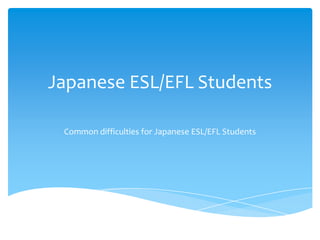
Japanese esl
- 1. Japanese ESL/EFL Students Common difficulties for Japanese ESL/EFL Students
- 2. Verb tenses in Japanese are conjugated through the verb form, as in English. However, Japanese has no auxiliary verbs, so the formation of progressive and perfect tenses becomes problematic. Furthermore, the verbs do not change for the person or number – so Japanese ESL students often forget that when conjugating the present simple third person in English an –s(or proper equivalent) is needed. Hence the common mistakes like“My brother work at….”. Grammatical issuesVerb Tense
- 3. Verb Tense Japanese ESL/EFL students often make the mistake of using the present simple to tell of future events, because that’s how it is done in Japanese. Often, context and implications are huge in Japanese.
- 4. There are numerous little variances between English and Japanese. The languages really have very few things in common. Sadly, when a small mistake is made in English, the sentence sounds completely childish and unrefined. This differences include things like the lack of relative pronouns in Japanese Therefore common mistakes like “He took out scissors and cut hair” instead of “he took out his scissors and cut his hair”. Relative Pronouns?
- 5. Japanese uses a particle system to mark topics, direct objects, etc… The particles are in the post position and describe the word before it. Therefore “The dog ate my homework” is “犬は私の宿題を食べた” with the first red character marking the topic dog (犬), the second marking possession of the homework to 私(I/me) before it, and the third marking homework (宿題) as a direct object. However, this setup shows that Japanese is a SOV language, AND does not have articles, but particles! If the sentence was translates directly symbol to word, it would be “Dog(topic) I(possesive) homework (Direct object) Eat –Conjugated to past tense.” SOV! (P)Articles?
- 6. Our sentence before, “犬は私の宿題を食べた” is actually a little more descriptive than natural Japanese. Usually in conversation implications are made and topics are not mentioned until a shift in topic occurs. Depending on the sentence before and after this, a more natural sentence would be something like “宿題を食べた” without even mentioning the topic, or “犬は食べた” without mentioning the object…depending on the context of the conversation. This also shows how relative pronouns don’t exist, but are rather implied. It also explains why some students may think they are saying enough, but westerners are not used to the idea of such implications. This has cultural roots in Japan, where direct confrontation is avoided to the point where it reflects in language. (to decline/say no to somone, saying “oh…well…” is more than clear enough. More problems beyond Grammar
- 7. Japanese only has 5 pure vowel sounds with long and short versions. Japanese also only has around 15 consonant sounds. All consonants sounds come with a vowel sound. This is relatively very few compared to English- and English also has complex consonant sounds while Japanese does not. Because of this, Japanese students often insert vowels between consonants when pronouncing English. (ie: Suturenguth) as opposed to “strength”) Other DifficultiesPhonology
- 8. The /r/ and /l/ pronunciation is probably the most consistently noticed problem for Japanese ESL/EFL students. the Japanese /r/ is actually what Native English speakers would see as a mix between an /r/ and an /l/. Because Japanese students are so used to a sound in the middle between an /r/ and an /l/, identifying/hearing the difference between the two is very difficult. English words have stress, while Japanese words have slight intonation. This creates problems for Japanese ESL/EFL students because words like “penalties” might come out with a stress on the middle syllable; making the word unrecognizable. Phonology (cont)/r/ vs. /l/or somewhere in between
- 9. The Japanese use two syllabaries and one logographic writing system. the language is almost completely logographic as opposed to alphabetic.Combined, they make thousands of characters. When different kanji (the logographic system) are combined, they can be read differently, combined differently, and must be learned over the course of many years. Other DifficultiesAlphabetic vs Logographic
- 10. Writing in Detail A good example of this writing system The word “Tokyo” consists of the kanji “east” and “capital”. Separate they are pronounced “Higashi” for east, and “Miyako” for capital. When placed together, they are pronounced “tou” and “kyo”. Not surprisning, the old capital (kyoto) uses the miyako kanji, but the to in “kyoto” is actually different. 京都 In the word “to eat” kanji is mixed with hiragana, forming a verb. The latter two characters are hiragana.
- 11. Now that you understand a little bit about the complexity of the writing systems matched with the simplicity of the phonological system, it’s easy to see why Brown & Haynes (1985) found that Japanese students outperformed in terms of visual discrimination, but not in terms of phonology. Though not grammatical, there are various other problems for Japanese ESL/EFL learners that they must overcome. Logographic vs. Alphabetic
- 12. The problems presented thus far are just the tip of the iceberg. Japanese and English are extremely different. The Japanese particle system makes it so things such as prepositions don’t even exist. Therefore the idea of what a prepositional phrase can do really has no equivalent Japanese counterpart to help explain its function. The painful Japanese educational system also does it’s fair share of harm to English language learning. Introversion is the norm, conversation practice is rare, and individual differences are not encouraged. Hopefully with the study of the problematic areas, matched with the study of the culture, ESL/EFL teachers can prioritize to avoid future disasters like the one seen here Problems ProblemsProblems